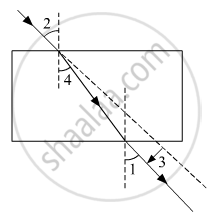Advertisements
Advertisements
Question
State two effects produced by the scattering of light by the atmosphere.
Solution
The scattering of light by the atmosphere makes
(a) the sky appear blue during the daytime
(b) the sun appear red at sunrise and sunset
APPEARS IN
RELATED QUESTIONS
What is atmospheric refraction? Use this phenomenon to explain the following natural events:
Twinkling of stars
Draw diagrams to illustrate your answers.
The correct sequencing of angle of incidence, angle of emergence, angle of refraction and lateral displacement shown in the following diagram by digits 1, 2, 3 and 4 is:

(a) 2, 4, 1, 3
(b) 2, 1, 4, 3
(c) 1, 2, 4, 3
(d) 2, 1, 3, 4
Why do stars seem higher than they actually are? Illustrate your answer with the help of a diagram.
The stars appear higher in the sky than they actually are, due to:
(a) diffraction of light
(b) scattering of light
(c) refraction of light
(d) reflection of light
As light from a far off star comes down towards the earth:
(a) it bends away from the normal
(b) it bends towards the normal
(c) it does not bend at all
(d) it is reflected back
We know that light refracts (or bends) when it goes from one medium to another. Now, the atmosphere contains only air. Then how does light get refracted on passing through only air in the atmosphere?
By how much time the day would have been shorter if the earth had no atmosphere?
Why does the sky appear blue on a clear day?
The stars appear higher from horizon than they actually are. Explain why it is so.
Assertion: Sky appears blue in the day time.
Reason: White light is composed of seven colours.
